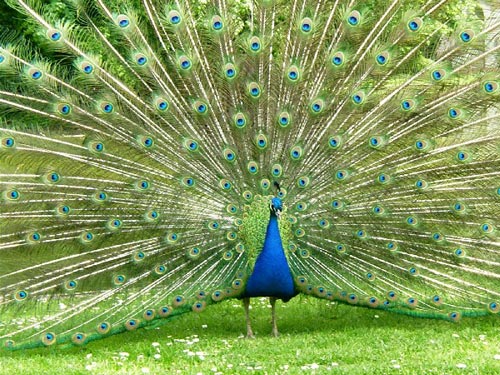Interesting facts about the public tail
The simple thing that everyone seems to know turns out to be almost wrong. The brilliant 'Tail' that we still see for a long time is not its true tail.
The real tail of the male peacock is quite small and nothing special. And the big, flashy tail that we see again is the hair on the back. To avoid this confusion, the ornithologists call it "train" - meaning the robe.
"Gown flap" can be up to 2 meters in diameter (not bad for a bird about 1 meter long).
Each of these brilliant turquoise hairs bears an iridescent eye. The plumes will grow in autumn and winter, and fall off every year during the summer.
At first glance, it seems that this colorful suit is a classic sex advertising tool of males. But over time, the data did not match this simple visualization.
First, male workers often spread their tails after their children began to accept flirtation, not before. While in theory, advertising must be done before she agrees.

(Photo: noahhunt.org)
Secondly, for many years, people still debate the relationship between this gorgeous tail and the male's ability to successfully mate. So far there has been no general consensus.
Is the length, the diameter of the eyes on the hairs, the number of eyes, or the frequency of the fibers, or the shape of the tail . the decisive factor for the success of this tail? The question is still unanswered.
In addition, the fact is that there is no big difference between the male flap of the male in the different populations. So, with a potential child, this guy's robe is as good as another guy's.
Finally, the quality of the robe does not accurately reflect the male's health condition and genome, thus turning it into a false sex advertising tool.
The above may make us hypothesize that the public tail may once be a meaningful advertising tool, but is now obsolete.
- A series of fun facts that answer your own eternal questions!
- 19 extremely interesting facts you should not ignore
- Interesting facts in Germany
- Discover interesting scientific facts
- 10 extremely interesting facts about clothes
- Going from one surprise to the other is different from the interesting things about all things
- 19 interesting facts about babies make adults suddenly fall back
- Top interesting facts about the world over 100 years ago
- Interesting facts about bones are not well known
- 10 interesting facts about world history
- 12 'super fun' facts that amaze you
- Interesting facts about giant birds
 Animal 'suffering' after hibernation
Animal 'suffering' after hibernation Why do goats climb well?
Why do goats climb well? Scientists were surprised to see chimpanzees eating turtles
Scientists were surprised to see chimpanzees eating turtles Giant catfish died deadly due to drought in Thailand
Giant catfish died deadly due to drought in Thailand